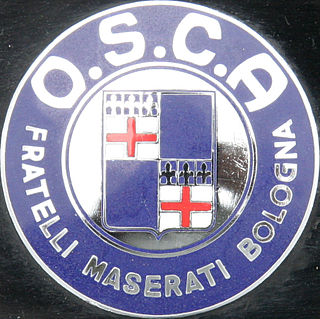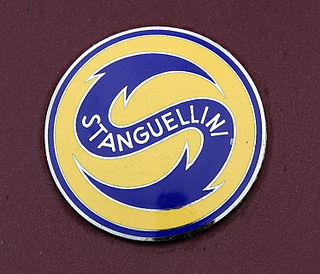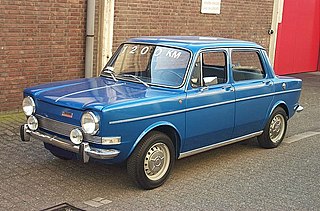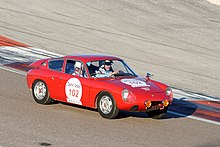
Maserati S.p.A. is an Italian luxury vehicle manufacturer. Established on 1 December 1914 in Bologna, Italy, the company's headquarters are now in Modena, and its emblem is a trident. The company has been owned by Stellantis since 2021. Maserati was initially associated with Ferrari. In May 2014, due to ambitious plans and product launches, Maserati sold a record of over 3,000 cars in one month. This caused them to increase production of the Quattroporte and Ghibli models. In addition to the Ghibli and Quattroporte, Maserati offers the Maserati GranTurismo and two SUV models, the Maserati Levante and the Maserati Grecale. Maserati has placed a yearly production output cap at 75,000 vehicles globally.

Abarth & C. S.p.A. is an Italian racing- and road-car maker and performance division founded by Italo-Austrian Carlo Abarth in 1949. Abarth & C. S.p.A. is owned by Stellantis through its Italian subsidiary. Its logo is a shield with a stylized scorpion on a yellow and red background.

Simca was a French automaker, founded in November 1934 by Fiat S.p.A. and directed from July 1935 to May 1963 by Italian Henri Pigozzi. Simca was affiliated with Fiat and, after Simca bought Ford's French subsidiary, became increasingly controlled by Chrysler. In 1970, Simca became a brand of Chrysler's European business, ending its period as an independent company. Simca disappeared in 1978, when Chrysler divested its European operations to another French automaker, PSA Peugeot Citroën. PSA replaced the Simca brand with Talbot after a short period when some models were badged as Simca-Talbots.

Gruppo Bertone, commonly known as Bertone, was an Italian industrial design company which specialized in car styling, coachbuilding and manufacturing. It was also a car manufacturing company.

Zagato is a coachbuilding company founded by Ugo Zagato in 1919. The design center of the company is located in Terrazzano, a village near Rho, Lombardy, Italy.

The Fiat 850 is a small rear-engine, rear-wheel-drive car manufactured and marketed by Italian car manufacturer Fiat from 1964 to 1973.

O.S.C.A. was an Italian manufacturer of racing and sports cars established 1947 in San Lazzaro di Savena, Bologna, by the Maserati brothers, and closed down in 1967. The company name is usually written OSCA or Osca.

The 1962 24 Hours of Le Mans was a motor race for Experimental cars and Grand Touring cars, staged at the Circuit de la Sarthe, Le Mans, France on 23 and 24 June 1962. It was the 30th Grand Prix of Endurance and the eighth round of the 1962 International Championship of Manufacturers.

Automobili Stanguellini was an Italian sport cars manufacturer based in Modena. The company was founded by Vittorio Stanguellini and was mostly active between 1946 and 1960. They produced racing cars until 1981, when Vittorio Stanguellini died. Since then, the company has been run by his son Francesco and offers service for the restoration, maintenance and operation of historic racing cars.

The Fiat 2300 is a six-cylinder executive car which was produced by Italian automotive manufacturer Fiat between 1961 and 1968. The 2300 was made as saloon, estate car and coupé. The 2300 saloon is noteworthy as in 1966 it became the first Fiat model to be available with an automatic transmission.

The Simca 1000, or Simca Mille in French, is a small, boxy rear-engined four-door saloon, manufactured for 18 years by French automaker Simca, from 1961 to 1978.

Bandini Automobili was an Italian automobile manufacturer operating between 1946 and 1992. It was named after its founder Ilario Bandini. It produced about 75 cars, of which around 40 were sold in the United States.
The Turin Motor Show is an auto show held annually in Turin, Italy. The first official show took place between 21 and 24 April 1900, at the Castle of Valentino, becoming a permanent fixture in Turin from 1938 having shared it with Milan and Rome until that time. From 1972, the show was held biannually and in 1984, it moved into Fiat's shuttered Lingotto factory.

The Fiat 1800 and 2100 are six-cylinder automobiles produced by Italian manufacturer Fiat between 1959 and 1968. Both models were introduced in 1959. A four-cylinder 1500-cc version, the 1500L, was added to the range in 1963, when the 2100 was replaced by the larger engined 2300. The 1800/2100 were designed by Fiat's own Dante Giacosa.

The Fiat-Abarth 750 is a compact sporting series of automobiles manufactured by the Italian manufacturing firm Abarth & C. of Turin, Italy in the 1950s and 1960s. The cars used the floorpan and often the bodywork of the Fiat 600 but were fitted with Abarth's modified engines. Abarth also offered a number of bodyworks by other designers for the 750 and its derivatives, most famously Zagato but also Allemano and others.

The Lombardi Grand Prix is a small, rear-engined sports car on Fiat 850 underpinnings. It was developed by the Carrozzeria Francis Lombardi with an in-house design by Giuseppe Rinaldi. The car was built from 1968 until 1972 and was also marketed as the OTAS 820, as a Giannini, and as the Abarth Grand Prix and Scorpione. It was first shown in March 1968, at the Geneva Motor Show. The design had a Kammback rear and a very low nose with flip-up headlights, and a large single windshield wiper. The pop-up headlights were electrically powered. The bodywork was all steel, except the rear panel. The design was originally shown as a prototype based on the front-wheel drive Autobianchi A112, and was adapted by Lombardi for the 850 sedan's floorpan. At Turin 1969 a targa version was also shown; called the "Monza", this open model has a rollover bar. At least two were built but it is unknown whether any were sold.

The Fiat Pininfarina Cabriolet was a two-door, two passenger, front engine rear drive convertible manufactured by Pinin Farina, and marketed by Fiat across two generations, superseding the Fiat 1200 Spider.

The Fiat Abarth 1000SP is a Group 4 and Group 6 sports racing car built by Abarth in 1966 and 1970.

Abarth Simca GT refers to a number of sports cars produced by Italian manufacturer Abarth between 1962 and 1965.
The Fiat Abarth OTR 1000, alternatively known as Fiat Abarth 1000 OTR, is a sport subcompact model automobile produced by the Italian automobile manufacturer Abarth. With its special "Radiale" engine, it was built between 1964 and 1969 in various versions in very small numbers based on the Fiat 850.




















